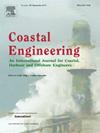波浪作用下单桩基础冲刷特性及预测模型试验研究
IF 4.5
2区 工程技术
Q1 ENGINEERING, CIVIL
引用次数: 0
摘要
近岸地区的破碎浪引起强烈的输沙,导致浅水区海上风电单桩基础周围冲刷严重,威胁结构稳定性。由于破碎波作用下单桩冲刷所涉及的复杂流动行为和土体响应,对单桩冲刷特性和预测模型的研究还不够充分。通过波浪水槽试验,系统分析了破碎波参数、单桩位置和水深对冲刷深度和形态的影响。采用三维激光扫描技术对海底地形的演变进行了研究。结果表明,破碎波引起了广泛的海底形态动力学变化,其特征是形成了一个条形槽体系,并叠加在单桩周围的局部冲刷过程上。此外,桩位参数α(即单桩与断裂点之间的距离与波长之比)对初级冲刷机制有显著影响,决定了冲刷深度和形态。当α在0.35 ~ 0.55范围内时,单桩位于湍流充分发育的区域,最大冲刷深度约为0.5D。随着破碎机类型由塌陷型向俯冲型转变,会促使条状槽体系的形成。反之,增加水深会产生水垫效应,抑制坝槽体系的形成,减小单桩冲刷深度。最后,提出了基于KC数、修正Ursell参数和单桩位置参数的单桩冲刷深度经验公式,可有效预测破碎波冲刷深度。本文章由计算机程序翻译,如有差异,请以英文原文为准。
Experimental investigation on scour characteristics and predictive model of monopile foundations under breaking waves
Breaking waves in nearshore regions induce intense sediment transport, leading to significant scour around offshore wind turbine monopile foundations constructed in shallow water areas, thereby threatening structure stability. Due to the complex flow behavior and soil response involved in monopile scour under breaking waves, the scour characteristics and predictive models have not been adequately investigated. This study systematically analyzes the effects of breaking wave parameters, monopile location, and water depth on scour depth and morphology through wave flume experiments. A three-dimensional laser scanning technique was employed to show the evolution of seabed topography. The results indicate that breaking waves cause extensive seabed morphodynamic changes characterized by forming a bar-trough system, which superimpose onto the local scour process around the monopile. Additionally, the pile location parameter α, defined as the ratio of the distance between the monopile and the breaking point to the wavelength, significantly influences the primary scour mechanism, determining the scour depth and morphology. Specifically, when α ranges from 0.35 to 0.55, the monopile is situated in the region of fully developed turbulence, and the maximum scour depth found was approximately 0.5D. As the breaker type transitions from collapsing to plunging, it can prompt the formation of the bar-trough system. Conversely, increasing water depth generates a water cushion effect, suppressing the formation of the bar-trough system and reducing the monopile scour depth. Finally, an empirical formula of monopile scour depth based on KC number, modified Ursell parameter, and monopile location parameter is proposed, which can effectively predict the scour depth in breaking waves.
求助全文
通过发布文献求助,成功后即可免费获取论文全文。
去求助
来源期刊

Coastal Engineering
工程技术-工程:大洋
CiteScore
9.20
自引率
13.60%
发文量
0
审稿时长
3.5 months
期刊介绍:
Coastal Engineering is an international medium for coastal engineers and scientists. Combining practical applications with modern technological and scientific approaches, such as mathematical and numerical modelling, laboratory and field observations and experiments, it publishes fundamental studies as well as case studies on the following aspects of coastal, harbour and offshore engineering: waves, currents and sediment transport; coastal, estuarine and offshore morphology; technical and functional design of coastal and harbour structures; morphological and environmental impact of coastal, harbour and offshore structures.
 求助内容:
求助内容: 应助结果提醒方式:
应助结果提醒方式:


